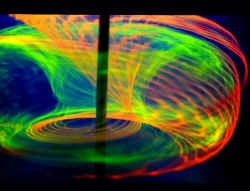Dye Doesn’t Follow Fluid Flow

It’s a morning ritual: Pour a cup of coffee, stir in some cream, and watch the color lighten from nearly black to a pleasing brown. The cream diffuses quickly as it traces the flow of coffee generated by your spoon. Most tracer particles follow that routine in nature, but now researchers have found a twist. In the 12 February PRL, a team shows that subtle changes in the forces acting on tracer particles can focus them within specific parts of the overall flow, creating unexpected stripes or eddies of high concentration. The effect could alter the rates of chemical reactions within mixing chambers, and it may influence the motion of water droplets in the atmosphere.
When particles get mixed into a fluid, some follow random trajectories, blurring into a smooth distribution throughout the fluid. In a cylindrical lab container stirred by spinning disks, this chaotic mixing forms a doughnut-shaped surface of whirling particles. However, other particles travel along the toroidal surface on orbits that carry them past the same spots again and again.
Ordinarily those repeated orbits don’t stand out if all tracer particles follow the chaotic fluid flow faithfully. But large or massive tracer particles can concentrate along specific trajectories, so their flow pattern is not representative of the overall flow. Now Fernando Muzzio and his colleagues at Rutgers University in Piscataway, NJ, have accidentally discovered another way to concentrate tracer particles into patterns: gradually alter their buoyancies or densities.
Graduate student Mario Alvarez had prepared two batches of fluorescent dye to inject into a cylindrical mixer containing glycerine. A batch of green dye was neutrally buoyant, so it spread into the glycerine to form the expected torus. However, a slightly less dense batch of red dye streaked into narrow chains. This behavior was puzzling, but after more experiments and some computer simulations, the cause seemed to be a time-dependent buoyancy: As the red dye slowly floats up, it gradually spreads out and becomes less buoyant. Parcels of dye may have enough upward speed to break into one of the horizontal bands of glycerine flow but then lose buoyancy and become trapped in them for long times. The dye would not form this pattern if it rose at a constant rate. “Because there is a transient change in the density over time, [the dye] becomes focused,” says team member Troy Shinbrot. “To me that is really bizarre.”
The main application is in modeling chemical reactions, Shinbrot says. Local temperature changes may cause some of the reactants to concentrate within narrow regions as they flow through a mixing chamber, leading to different reaction products in different spots. Shinbrot also speculates that transient solar heating of water droplets in the air would alter their buoyancies enough to form focused eddies, thus affecting the dynamics of clouds.
The research throws an interesting curve into models of how impurities travel through dynamic fluids, says physicist Thomas Solomon of Bucknell University in Lewisburg, PA. “This clearly is a new mechanism by which focusing can occur within real flows,” he says. “It merits more discussion, and the paper throws it open for the community to try to interpret.”
–Robert Irion
Robert Irion is a freelance science writer based in Santa Cruz, CA.


